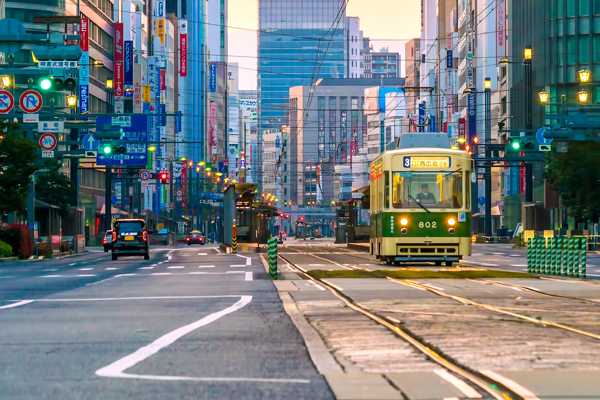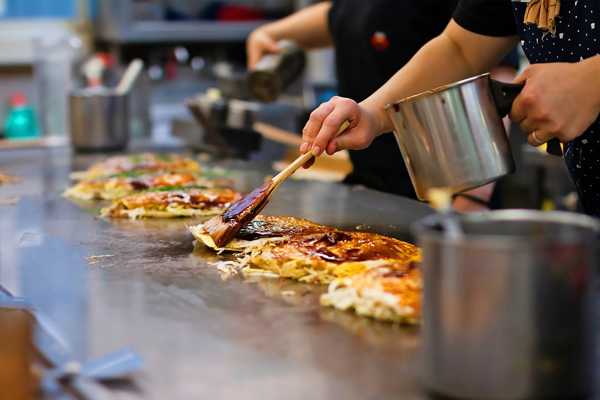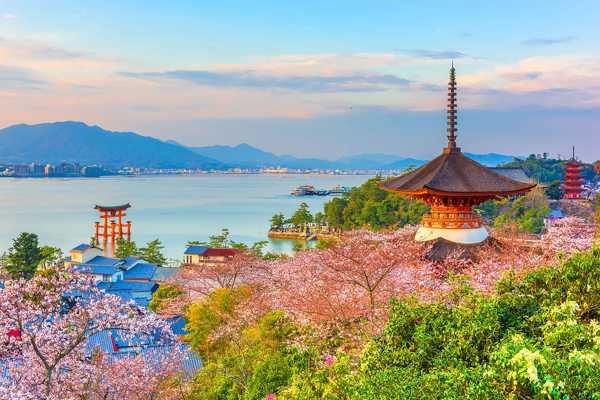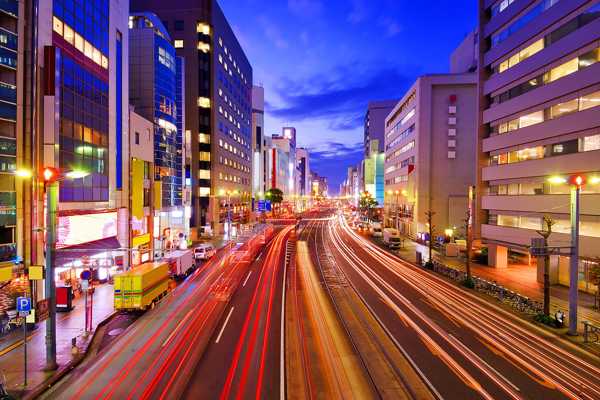Hiroshima is a castle town flanked on the south side by the Seto Inland Sea, which is full of fresh seafood, and behind by the lush Chugoku Mountains. It's no surprise that Hiroshima is overflowing with delicious food.
Local delicacies include okonomiyaki (a Japanese-style pancake dish), oysters, and ramen. These delicious foods are also nutritious and healthy, which is a bonus. You can enjoy the authentic flavours of Hiroshima at lunch, during a break from sightseeing, or for dinner in the evening. There are also unique delicacies that can only be eaten in season. There are all kinds of souvenir sweets to explore, too, so you'll quite literally be like a child in a sweet shop.
- 1
Okonomiyaki
Hiroshima Prefecture's soul food is full of nutrition and volume

- Cibo
Okonomiyaki (a Japanese-style pancake dish) is made from flour, cabbage, meat, egg, and other ingredients cooked on a large teppan (iron hot plate). Hiroshima Prefecture has a higher number of okonomiyaki restaurants per 10,000 inhabitants than anywhere else in Japan.
A wide variety of styles of okonomiyaki can be found across the country, but the most common type in Hiroshima is layered, in which cabbage and other ingredients are cooked in layers on top of the batter. This is often combined with noodles such as ramen noodles, so when it’s cut, you see a layered cross-section of ingredients. Local Otafuku Sauce or Carp Sauce are used for seasoning. Understandably, some locals feel strange calling the dish “Hiroshima-style” and instead simply ask for “okonomiyaki”.
Posizione: Hiroshima Prefecture, Japan
Mappa - 2
Oysters
Experience the taste of the sea in Japan's largest oyster-producing area, Hiroshima Bay

- Cibo
Oysters are a traditional Hiroshima delicacy. Oyster farming here has a history of more than 400 years, and more than half of Japan’s oyster production comes from Hiroshima Prefecture.
In winter, when they’re in season, oyster events are held in various places along the coast, adding to the fun of a winter trip to Hiroshima. In recent years, a year-round variety called Kaki Komachi, which is meaty and delicious in any season, has been developed. Common ways to eat oysters are fresh, grilled, or fried, but Hiroshima has many other oyster dishes too.
Posizione: Hiroshima Prefecture, Japan
Mappa - 3
Tsukemen
Enjoy these cold noodles with spicy sauce and plenty of sesame and chilli oil

- Cibo
Hiroshima tsukemen (dipping noodles) are boiled noodles cooled with ice water and served with a dipping sauce. Once you try it, you’ll be hooked.
The dipping sauce is typically spicy. Let's say very hot. It’s soy sauce-based, with chilli, chilli oil, vinegar, sesame, and other condiments, and you get a real hit of umami and sweetness from the broth, which is made with small fish, despite the spiciness of the dish. Piled high on top of the noodles are char siu, boiled vegetables such as cabbage, cucumber, spring onion, boiled egg, and other ingredients. It goes very well with the spicy dipping sauce. This dish originated around 1954. Specialty restaurants started to appear in the 1980s, and by the 2000s it was famous throughout Japan.
Posizione: Hiroshima Prefecture, Japan
Mappa - 4
Onomichi ramen
Local ramen that has become famous nationwide for its rich soy sauce flavour

- Cibo
Onomichi ramen is a local noodle dish from Onomichi, a city facing the Seto Inland Sea. Onomichi is a popular tourist destination thanks to its historic townscape and beautiful seascape.
Onomichi ramen soup is made from chicken stock mixed with seafood broth using dried sardines, seasoned with soy sauce. Its rich flavour is enhanced by floating bits of pork fat. The noodles are normally chewy and flat. And the soup completely covers the noodles. Toppings are simple: lightly flavoured char siu (slices of braised pork), menma (seasoned bamboo shoots), and chopped green onion. Many local restaurants call this dish chuka soba (Chinese noodles) instead of ramen.
Posizione: Onomichi City, Hiroshima Prefecture, Japan
Mappa - 5
Conger eel
A must-try delicacy from Miyajima, home to Itsukushima Shrine

- Cibo
Conger eel has been eaten around Miyajima in Hiroshima Bay for as long as anyone can remember. Today, anago meshi (conger eel with rice) is Miyajima’s most celebrated dish.
It’s said that anago meshi, slowly grilled fluffy conger eel served on warm rice with special sauce, was first sold as a boxed lunch at the old Miyajima Station, established in 1897. It even won the title of Japan’s best boxed lunch sold at a railway station. When sightseeing around Miyajima, you can enjoy it at many restaurants including Ueno, the restaurant where it was first served. Anago meshi boxed lunches are also available for takeaway.
Posizione: Hiroshima Prefecture, Japan
Mappa - 6
JSMDF Kure Curry
Try the curry eaten onboard Japan's Maritime Self-Defense Force ships

- Cibo
JMSDF Kure Curry is a Navy dish and a local food of Kure City. Kure, which is an excellent natural harbour, has long been a base for Japan’s Imperial Navy and Maritime Self-Defense Force.
Navy dishes were designed to help the JMSDF crews stay healthy during long periods at sea. Curry rice is especially famous and the custom of making Friday a day to eat curry took hold because living at sea can make it difficult to tell which day of the week it is. JMSDF Kure Curry is a special curry that faithfully reproduces the flavour of the real thing with the help of a cook from a unit belonging to JMSDF Kure Naval Base, and it’s even certified by the captain of the ship. You can eat it at restaurants throughout Kure City.
Posizione: Kure City, Hiroshima Prefecture, Japan
Mappa - 7
Kaki no dotenabe
A miso-flavoured oyster hot pot dish perfect for cold days

- Cibo
Kaki no dotenabe (oyster hot pot) is a hot pot dish in which a mixture of miso coats the inside of the pot and is enjoyed while cooking raw oysters and vegetables. It’s said to have originated in Hiroshima, which provides more than half of Japan’s entire oyster production.
The miso is mixed in as you eat, so you can adjust the taste to your liking. The soup combined with the oyster flavour is both delicious and nutritious. It’s also perfect for warming yourself up on a cold winter’s day. The key is to eat the oysters quickly as soon as they’re cooked all the way through, because they’ll start to shrink if overcooked. You can try this dish at Japanese cuisine restaurants, izakaya, and Japanese-style hotels throughout Hiroshima Prefecture.
Posizione: Hiroshima Prefecture, Japan
Mappa - 8
Koiwashi
A Hiroshima soul food that can only be eaten while fresh

- Cibo
The fish called koiwashi (small sardine) in Hiroshima refers to anchovy. The season for koiwashi runs from June to August, with fishing opening on the 10th of June every year. The catch is said to account for 60 to 70% of the total catch in Hiroshima Prefecture.
Anchovies are normally processed into dried fish, and baby anchovies are processed into shirasu (fresh, dried, or boiled whitebait), but freshly caught full-grown fish are served as sashimi or tempura in Hiroshima Prefecture. Hiroshima Bay in the western part of the prefecture is the main fishing ground. Because raw anchovies are easily perishable, you can enjoy them only in Hiroshima Prefecture. You can order koiwashi at Japanese cuisine restaurants, sushi restaurants, and izakaya (Japanese-style pubs) throughout Hiroshima.
Posizione: Hiroshima Prefecture, Japan
Mappa - 9
Monaka
A classic Japanese sweet with a delicious combination of crispy wafers and bean paste

- Cibo
Monaka is a traditional Japanese sweet in which thin wafers made from glutinous rice flour are filled with a variety of pastes. You can try local variations of monaka at locations throughout Miyajima Prefecture.
Monaka wafers are moulded and baked and come in a variety of shapes such as lucky cranes and tortoises, chrysanthemum flowers, and maple leaves. The same goes for the filling, which ranges from red bean paste to white bean paste with matcha green tea or yuzu citrus flavours. The combination of wafer and filling gives each producer their own unique characteristics. In Saijo, a city famous for sake brewing, you can even try monaka filled with white bean paste with a scent of sake.
Posizione: Hiroshima Prefecture, Japan
Mappa - 10
Momiji manju
Try these grilled dumplings with sponge cake dough in the shape of maple leaves

- Cibo
Momiji manju (maple leaf-shaped cake with filling) is a baked sweet in the shape of a maple leaf, which is the official tree of Hiroshima Prefecture. It was originally a Miyajima delicacy, but it’s now more widely known as one of the most popular souvenir sweets of Hiroshima Prefecture.
The standard type of filling is a smooth red bean paste, but other varieties include mashed red bean paste, white bean paste, matcha green tea-flavoured bean paste, and chestnut paste. Unique flavours are available, too, such as custard cream, chocolate, cheese, and age-momiji (deep-fried momiji manju), which is dipped it into the batter and deep-fried. Take your pick!
Posizione: Hiroshima Prefecture, Japan
Mappa


















